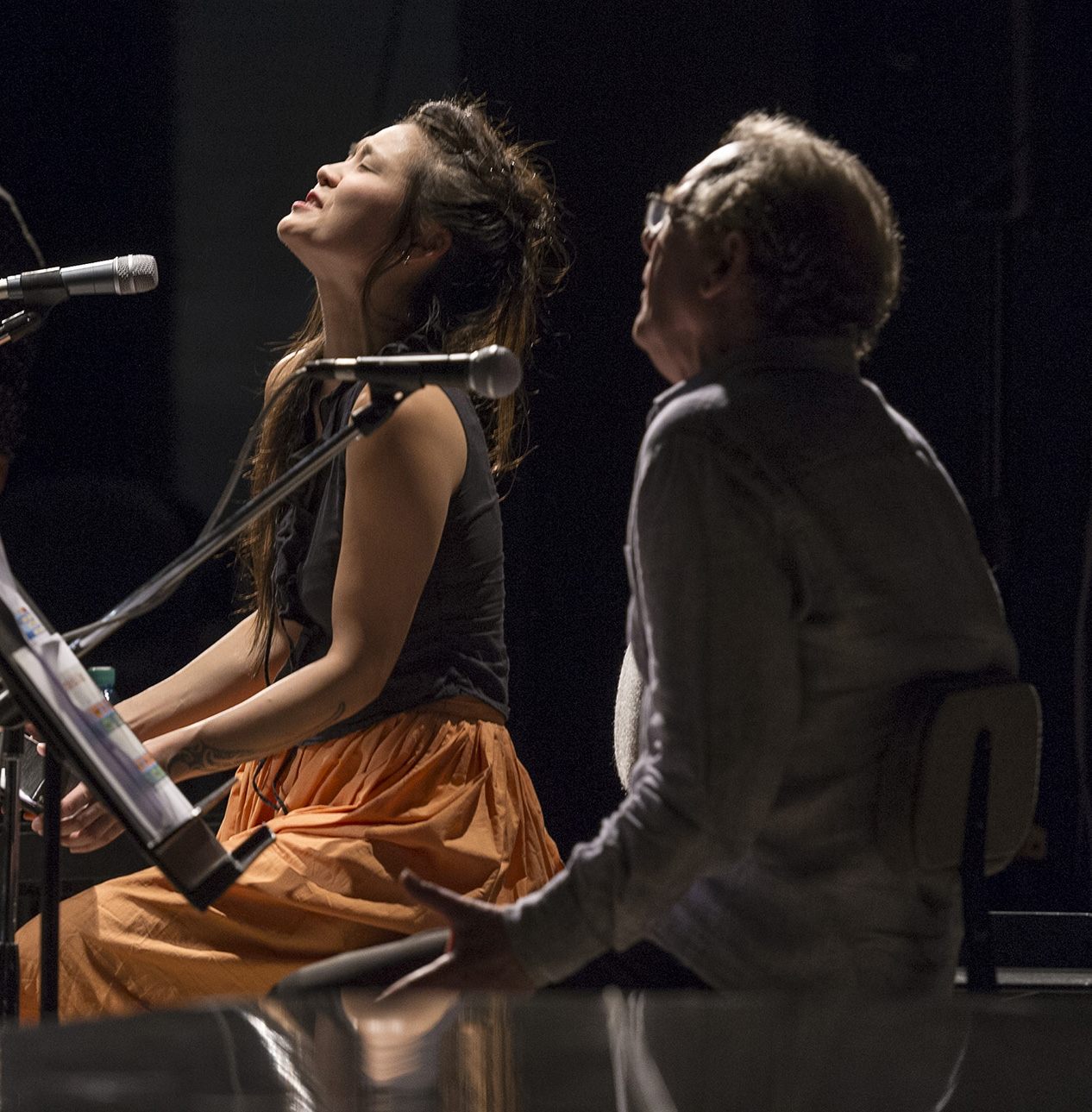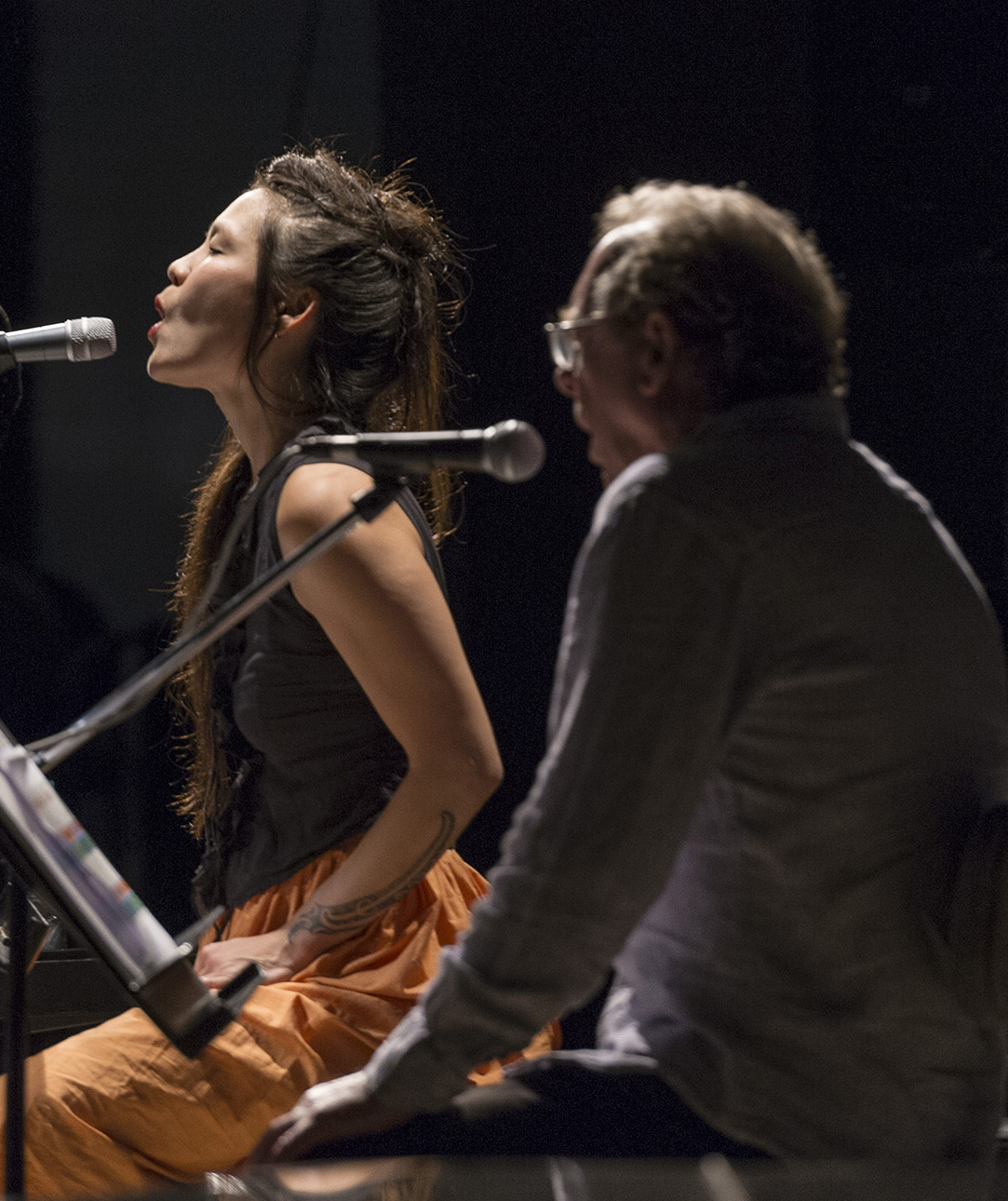A Book of Hours
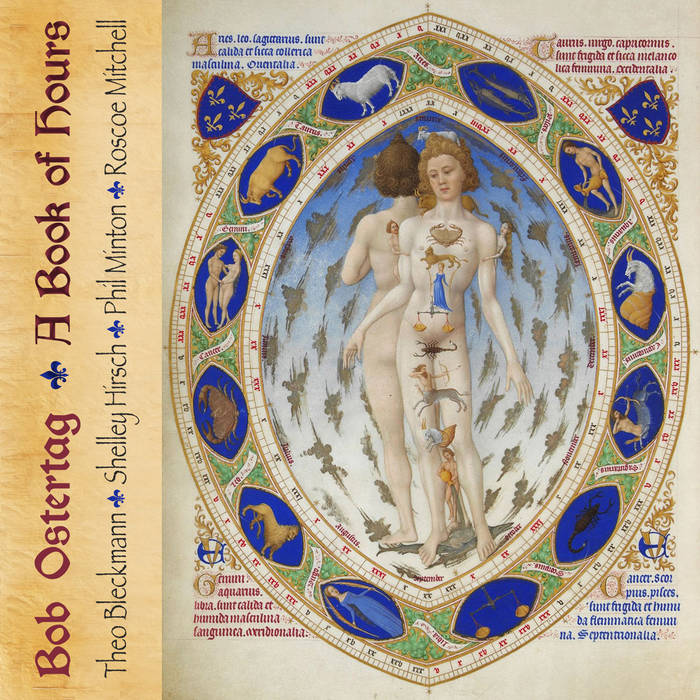
“The sophisticated and earnest best of what experimental music always offers but rarely delivers. 50 minutes of thought, weirdness, and formal precision.”
– The Wire (click here for the complete review)
A Book of Hours is a composition, a recording, and a performance ensemble. Bob’s first ensemble project in nearly twenty years, and his current main priority for live performances. The project began as a commission from WDR 3 open: studio akustische kunst. The world premiere radio broadcast was presented on Westdeutscher Rundfunk (WDR) Radio Köln, February 17, 2012. The recording was then released for Internet download, also in 2012. The ensemble included Theo Bleckmann, Shelley Hirsch, and Phil Minton (voice), and Roscoe Mitchell (reeds).
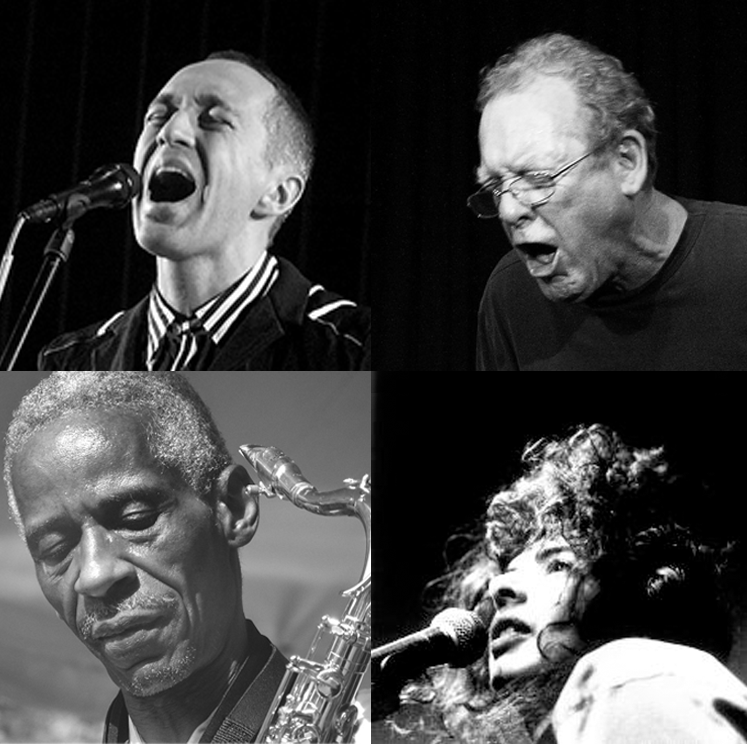
The world premiere performance was presented at the Teatro Colón in Buenos Aires, Argentina, in March 2015. The ensemble included Bleckmann and Minton, as well as Audrey Chen (voice) and Henrik Monkeby Nørstebø (trombone). La Nación published this interview the day of the concert. The performance received a glowing review in Clarin.
A Book of Hours in concert at the Teatro Colón, Buenos Aires
A Book of Hours European premiere
A Book of Hours European premiere
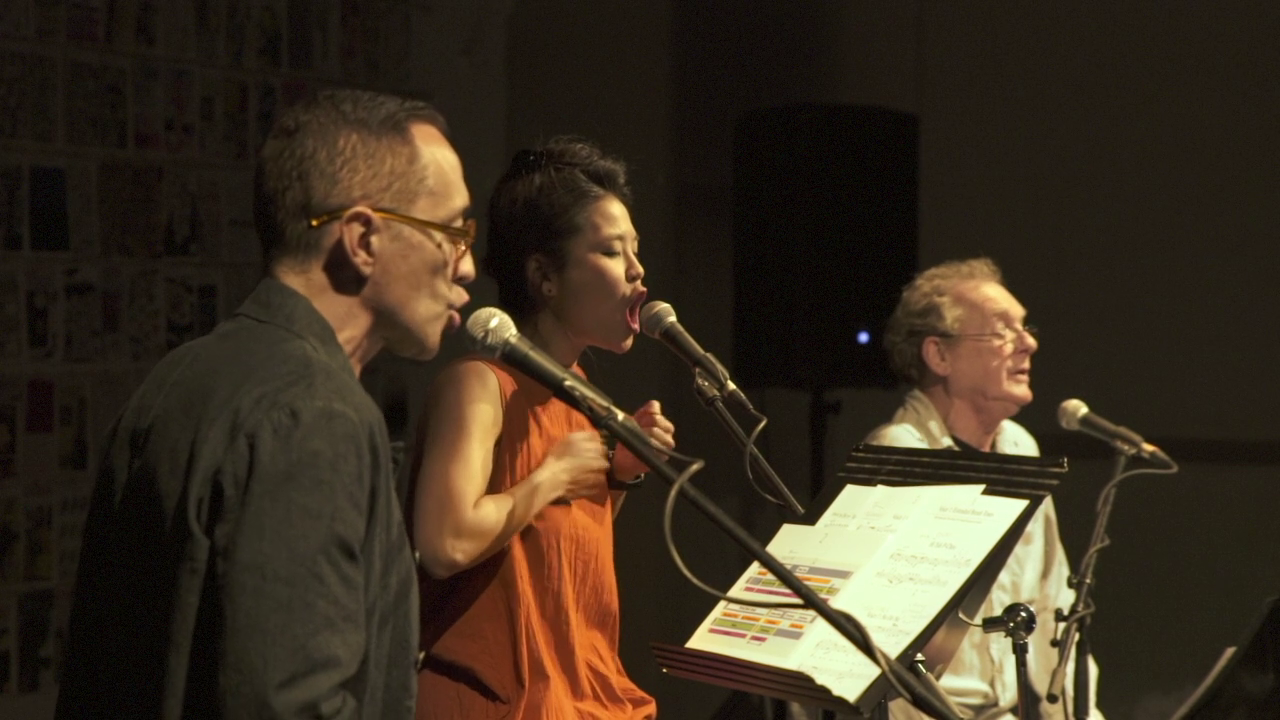
A Book of Hours, Prague
The European premiere was presented at the Vs. Interpretation Festival in Prague, Czech Republic, in April 2015. This performance featured Ostertag, Bleckmann and Minton, with Audrey Chen both singing and performing the instrumental part on cello.
Composer’s Notes
Completing A Book of Hours has me thinking about Karlheinz Stockhausen’s Gesang der Jünglinge. Both works were commissioned by WDR Radio Köln, both are primarily vocal, both are “sacred” in their own ways, and both address the meeting of the human body and human technology via the electronic manipulation of voice. Yet in other ways the two works are opposites.
Stockhausen’s work was completed in 1956 and is very much a product of its time. Like many of his contemporaries, Stockhausen believed that the timbral resources of acoustic music – voice and the instruments of the Western orchestral tradition – had been thoroughly explored and exhausted. Further explorations in timbre would henceforth occur in the electronic domain, which promised to make sound far more malleable, and give composers far more precise control, than acoustic music ever did. For Gesang der Jünglinge, Stockhausen wanted to create a seamless continuum with human voice at one end and purely synthetic sound on the other. By breaking down the human voice into its sonic components and then recreating them electronically, the composer hoped to transform the resulting hybrid voice in ways previously unimaginable. Electronic music was still in its infancy, and the tools available for the electronic manipulation of sound were extremely crude compared to the tools we have today. But Stockhausen devised an ingenious (and extremely laborious) method for creating synthetic equivalents of recorded human voice, as well as a system for extrapolating those sounds in ways not possible with a human voice.
Then, just a decade later, a new generation of improvising musicians uncovered vast worlds of previously unknown sound (at least to Western ears) in exactly those instruments and voices that the high art composers of the 1950s had dismissed. Prominent among this new generation were Roscoe Mitchell, a young saxophonist in Chicago working in the newly formed Association for the Advancement of Creative Musicians, and Phil Minton, a vocalist in London’s new “free improvised music” scene. This new generation was joined a decade later by younger musicians including vocalists Shelley Hirsch and Theo Bleckmann, myself, and many others.
The musical resources developed by these musicians was staggering: Derek Bailey’s guitar harmonics, Anthony Braxton’s extended techniques on a diverse assortment of reed instruments, Evan Parker’s combination of circular breathing and reed overtones, Lester Bowie’s trumpet vocalizations, and much much more.
How could it be that the high art composers of the twentieth century, as obsessed as they were with being the “pioneers” of new sound, failed to notice this motherlode of sonic possibility that was right under their noses all the time? The answer lies in the very notion of “composer,” which reached its zenith of ossification in the twentieth century. By Stockhausen’s time, the composer was understood to be an exalted creative genius who retired to his (yes, it was almost always his) tower from where he contemplated the world, deciphered the correct set of instructions for creating the best possible music, and passed these instructions down from on high in the form of symbols on paper to the lowly instrumentalists who were then to execute the instructions. In fact, some twentieth century composers thought that the most profound promise of electronic music was the liberation of the composer from reliance on necessarily imperfect human interpreters for the realization of their musical visions. Stockhausen himself was perhaps the paradigmatic example of the twentieth century genius composer, and the many claims that Gesang der Jünglinge was “the first masterpiece of electronic music” were specifically intended to both burnish his credentials as such, and to usher the figure of the genius composer into the electronic age.(1)
The vast world of sound unearthed by the following generation of improvisors was simply not available to “composers,” for the only route to these new musical worlds was through the direct, bodily encounter with the instrument itself, hour upon hour, week by week, year after year. And this had to be accomplished without symbolic instruction getting in between the musician and the instrument. The encounter of human body and instrument had to be as intimate as possible.
Among all the discoveries that resulted, none was more compelling than the discovery of the range of the human voice, the original instrument. As evidence for this claim, I submit the work of Phil Minton, Shelley Hirsch, and Theo Bleckmann in A Book of Hours, each one utterly unique and beautiful.
When Stockhausen wrote Gesang der Jünglinge, his choice of vocalist was largely inconsequential. Any voice would do, even a child’s, because the real development of the composition would be done electronically. The voice was just fodder, “source material” in contemporary parlance. My approach in A Book of Hours has been just the opposite: the choice of musicians determined everything. If any one of the four musicians had been different, a completely different work would have resulted. And they most certainly could not have been children. This is music that could only be made through the accumulated musical wisdom of decades of individual musical exploration. It is no coincidence that two of the musicians, Roscoe Mitchell and Phil Minton, are in their seventies (born just three months apart in 1940). Thus the subtitle, Gesang der Alten.
Another big discovery of the fifty years since Gesang der Jünglinge has been that the electronic manipulation of sound is not the panacea that Sockhausen’s generation imagined. Yes, the tools available are far more sophisticated than what Stockhausen had access to at WDR in 1956. And yes, these tools have given rise to entire genres of electronic music, as well as sub genres, micro genres, and so on. And yet electronically synthesized sound always carries with it the instantly identifiable thumbprint of the synthetic. Which is why, in A Book of Hours, I have chosen not to electronically modify the sounds created by the musicians, which I find to be incredibly rich and compelling. Any electronic “processing” I might have performed on them would have had the inevitable effect of somehow reducing them, of flattening them into something less multidimensional and organic. So the only electronic processing I have done is to use a synthetic reverb to place the musicians, who recorded their material separately in different locations, into the same synthetic “space.”
And yet, though the sounds in A Book of Hours could never have resulted from the instructions of a composer but could have only been created through improvisation, the composition I have created could never have been improvised. The music is far too deliberate, from the meta structure down to the details of each specific phrase. There is almost nothing here that is presented as it was originally played or sung (with the exception of some saxophone parts, which were indeed incorporated “as is”). What I have done is splice: hundreds and hundreds, maybe thousands of splices.(2) I have also done some slight time stretching or compressing, and equally minor pitch transposition, of the original material. None of this was done to change the “sound” of the musicians, or to make them appear to sing higher or lower or faster or louder than they can. Rather, these slight changes were done to make the parts fit together better. And this was a difficult challenge, because the project began with each of the four musicians recording a set of solo improvisations, separately and without any knowledge of what the others were doing.
A Book of Hours is thus precariously balanced between improvisation and composition. The actual singing and sax playing is far too intimate to the body of each musician to have possibly resulted from the musicians attempting to execute the instructions of a composer, while the economy of detail and deliberateness of structure is far too tight to have possibly resulted from improvisation. Is A Book of Hours composed or improvised? It is both and neither. Like Stockhausen in Gesang der Jünglinge, I have tried to fashion a work that resides in what roboticist Masahiro Mori termed the “uncanny valley” between human and machine. Mori suggests that humans respond positively to robotic replicas of themselves if the replicas are not very exact, but when the replicas’ likeness to humans crosses a certain threshold they fall into an “uncanny valley” where our delight turns to revulsion. But unlike Stockhausen’s work and indeed so much of the terrain of the uncanny valley, I have tried to make something that results not in revulsion but retains a sort of organic beauty. (I find Gesang der Jünglinge nearly impossible to listen to today, much more of a Frankenstein nightmare than a flowering of the future).
Finally, Stockhausen claimed to be a devout Catholic, and Gesang der Jünglinge was all about praising God. Eventually, Stockhausen’s claims about his special relationship with God fused with his stature as genius composer into a sort of amalgam of God and Stockhausen that was absurd. Books of hours were medieval prayer books that provided prayers for each hour of the day, and date to a time when clocks were new enough to be thought to have religious significance. (Then again, the laptop on which I created this work is run by a clock, which divides time not into hours but into 2,660,000,000 parts of a second, and there are indeed some devotees of technology that approach this fact with a religious reverence.) I think of A Book of Hours as devotional music for non-believers, or, in the words of my friend Our Lady J, gospel for the godless. The devotion it expresses is not to any god but rather the beauty of the world in which we live, as made manifest in the breath, the voice, and the reed. The subtitles are taken from psalms, chosen by the criteria that they should make no mention of God.
In all of this I am further developing the compositional techniques I created in the 1990s with my Say No More quartet and its four recordings. There also, I began with solo improvisations recorded separately, which I then fashioned into compositions via thousands of splices. The only methodological difference between Say No More and A Book of Hours is that there are digital tools for altering the pitch and duration of recorded sound that were not available in the 1990s. The Say No More project progressed in cycles, with the composition I created on the computer from the fragments of the solo improvisations in turn becoming the “score” that the live ensemble used in its performances; the live performance recordings then becoming the source material for another composition spliced together on the computer; and so on. Given the present world financial crisis, I am unsure if the resources to pursue A Book of Hours through a similarly ambitious set of cycles will be available, and at any rate I am traveling much less in an effort to reduce my carbon footprint in the face of global warming. But I will be happy even if the present recording is the final stop for A Book of Hours, as I find the recording quite beautiful in and of itself. My most heartfelt thanks to Roscoe Mitchell, Phil Minton, Shelley Hirsch, and Theo Bleckmann for allowing me the honor of working with their incredible music without restriction.
(1) Stockhausen did engage in musical improvisation, but always in ensembles under his direction, and he adamantly claimed authorship of these “compositions,” even when the score was almost non-existent (as did John Cage and many other avant-garde composers). He also continued to write for both acoustic instruments and electronics throughout his life. More to the point here, neither his improvisations nor his writing led to the sort of deep encounters with extended instrumental technique that are my subject here.
(2) Interestingly, it was not a composer but the pianist Glen Gould who first pointed out the profound implications of the splice, implications which we see all around us, from iTunes playlists to club DJs. See Glenn Gould’s seminal but under appreciated essay, “The Prospects of Recording.”

